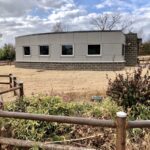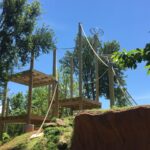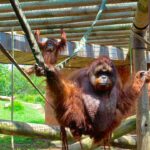Epsten Group, in partnership with Ursa International, has been fortunate to have worked with Oklahoma City Zoo since 2016, collaborating on several projects ranging from Master Plan services to habitat design for many of the Zoo’s diverse inhabitants. Epsten Group has worked since 1991 as pioneers of sustainability in the built environment across a myriad of building types, including dozens of zoo facilities across the country. With closely oriented missions focused on conservation and sustainability, Epsten Group and Oklahoma City Zoo have partnered to create facilities that ensure a brighter future for all living beings through care and conservation of natural habitats.
Our work with the Oklahoma City Zoo began nearly a decade ago, when Ursa International designed the Zoo’s Master Plan. Ursa comprehensively reviewed the entire 120-acre+ site, working with decision-makers and animal caretakers within the Zoo to determine the best way to serve animal and visitor experiences. The 10 year/$71 million Master Plan was approved in October 2017, and laid crucial groundwork for our collaboration with the Zoo in the years to come.
The first major project of the new Master Plan was for the Galapagos Tortoise Exhibit, wherein Epsten Group and Ursa International were honored to create a new, modern habitat located just inside the Zoo’s entrance. Galapagos Tortoises are some of the longest living animals in the world, and with the Zoo’s group of four as its oldest inhabitants, it was crucial for the habitat design to delicately care for these incredible creatures.
The new habitat consisted of one indoor and two outdoor spaces. The climate-controlled 900 SF indoor habitat contained a new nesting area, an indoor pool, a combination of heated and natural substrate floors, a vestibule for animal caretakers with a sink, and utility space. It also featured an open-air viewing area for Zoo guests. The outdoor spaces total 8,000 SF, open for the tortoises to roam with natural boulders, a log wall and native landscaping, which prevents water run-off and drastically improves air quality.
As a part of the Zoo’s continued execution of the Master Plan, the existing Ancient Andean Condor Exhibit was demolished, and a new exhibit area was envisioned for what is now Raptor Ridge. The raptor species is listed as near threatened by the International Union for Conservation of Nature and is also one of the biggest birds on Earth that is able to fly, so intentional, spacious, and careful habitat design principals were of the upmost importance.
This new space adaptively reused an abandoned set of grottos into a set of modern Aviaries with adjacent holding areas. One large aviary structure was added over the existing grottos subdividing it into two condor aviaries. One Aviary is seen as the main enclosure, where the second is a “retirement aviary” for separating older and/or less sociable birds from the rest of the collection, as many members of this species are solitary creatures. The remaining grotto walls are reminiscent of the cliff walls used by condors as they travel the skies.
Oklahoma City Zoo’s two resident Sumatran orangutans, Elok and Negara, tend to be guest favorites, as they are easy to distinguish from one another and have an abundance of personality. Unfortunately, all three species of orangutans are classified as critically endangered in the wild, with the latest estimate for the Sumatran population being as low as 15,000 individuals (x). It was imperative that Epsten took careful measures to further enhance the Zoo’s conservation efforts for this important species, and as these fascinating animals are the largest tree-dwelling animals in the world, our renovation of their exhibit required an intent focus on enriching arboreal features to ensure the animals thrived throughout their habitat. A set of elevated decks, ladders and high nests provide a complex environment for shade, relaxation and high perches for the group to enjoy above the visiting public while exhibiting their natural behaviors and strengths.
The importance of the intersection of sustainability and conservation cannot be overstated; they work hand-in-hand to ensure that vulnerable species are not only cared for in captivity, but that their natural habitats and populations are protected and enabled to flourish. The Association of Zoos and Aquariums (AZA) holds accredited facilities to standards that ensure all animals are compassionately cared for and protected, which in turn, allows these incredible creatures to serve as representatives in advocacy for the protection of their species and natural habitats.
To learn more about what you can do to help Oklahoma City Zoo continue to steward its decades-long mission of animal welfare and conservation, visit their website to support their conservation efforts both within and beyond the limits of the Zoo. If you are interested in partnering with Epsten Group and Ursa International on an upcoming Zoo project, reach out to us here—we can’t wait to hear from you.







